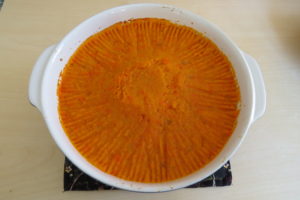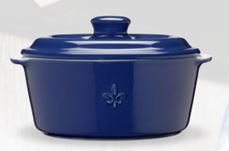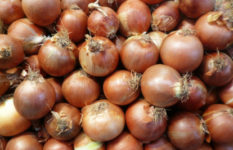We made this the other night in a fit of ‘What the hell are we doing?’ It’s pie in the sense of ‘shepherds’ and ‘cottage’. So does that make it ‘henhouse’ pie? Who knows. Let’s get to the food.
It serves 3 hungry people for a dinner or 4 people with more moderate appetites.
 Ingredients
Ingredients
1 large sweet potato
1 enormous carrot (ours was probably 25cm long x 5cm diameter)
3 large chicken breasts
9 pickling onions (or 3 small normal onions)
1 tbsp soy sauce
1 dessert spoon of flour
3 or 4 generous pinches of dried fenugreek leaves
A couple of pinches of salt
200g Petit pois
200g Sweetcorn niblets
A drizzle of pomace
A smaller drizzle of sesame oil
A knob of butter
2 dessert spoons of Crème Fraîche
Method
- Peel and dice the sweet potato and carrot into pieces roughly a couple of centimetres across.
- Place in separate saucepans in salted water and boil them for 15-20 minutes or until soft.
- Drain the water away, then mash together until smooth (or still a bit knobbly, your choice). Set aside. Set the oven to heat to 220°C/428°F/Gas mark 7.
- Dice the chicken into bitesize pieces. Add the soy sauce and set aside to marinate.
- Peel and halve the onions. If you’re using small normal onions, quarter them.
- Place the flour, salt and fenugreek in a bowl and mix.
- Add the chicken to the flour mix and stir thoroughly. Cover and set aside.
- Heat the oils and the butter in a large frying pan. On a high light, cook the onions until they start to brown, turning regularly.
- Add the chicken pieces and cook until the outsides are mostly white.
- Add the peas and sweetcorn, stirring them in to heat through.
- Turn off the light under the food and remove the pan from the heat to allow it to cool for a few moments – until the sizzling stops.
- Add the crème fraîche and stir through.
- Transfer the chicken mix to the bottom of a 20cm cocotte and flatten it out.
- Cover the chicken with the sweet potato and carrot mash, smoothing it out to the edges. Make a starburst or other pattern in the top with a fork if liked.
- Place the cocotte, uncovered, in the oven for 20 minutes.
- Remove from the oven and serve hot.
Glossary
| Cocotte | 1. A heatproof dish in which food can be cooked and served. (see Fig. 1) 2. A fashionable prostitute. (probably best to use the other type) |
| Crème Fraîche | The French version of soured cream, crème fraîche is twice as rich and twice as thick. It’s made from pasteurised cows’ milk to which a lactic bacteria culture has been added. This thickens the cream and gives it a distinctive sharp flavour. (BBC) |
| Fenugreek | An aromatic Mediterranean plant that produces long pods containing oblong, brownish seeds. The seeds have a slightly bitter taste and are roasted and ground and used as a flavouring in curries. The leaves from the plant (often sold as methi) can be used in salads, and both fresh and dried leaves are used in Indian cookery. The seeds and the leaves have a strong aroma. (BBC) |
| Pickling onions | Pickling onions are small tender white or yellow onions with a mild flavour. They range in size from 1/2″ to 1″ in diameter. Pickling onions can also be used in place of pearl onions or any small mild-flavored onion called for in recipes. (see Fig 2) |
| Pomace | Olive Pomace Oil is a cooking grade oil. It’s obtained by treating the olive residue paste (after the fruit has been pressed) with solvents to extract the oil (exactly as for corn, sunflower, etc.) and then frequently blending this product with another oil such as rapeseed, peanut or even extra virgin olive. It is a light oil with neutral taste and flavour and is the most suitable for high temperature cooking due to its high smoke point. The unregulated preparation of pomace can leave harmful residue in the product, but as long as you’re buying something from a member of the International Olive Council quality control programme or an EU member country, you shouldn’t have any problems. There is some debate among olive oil aficionados as to whether extra virgin or pomace is better. The only real difference is the flavour. First press will always be much more flavourful. In all other respects, the end product is exactly the same so it really just boils down to what you want it for and your own personal tastes. |
| Sweet Potato | A root vegetable that resembles a potato, although it is quite different in taste and texture (and is not related to the potato). It has a pinkish-orange skin and a deep-orange, creamy-textured flesh that’s much lighter and fluffier than that of the potato. Sweet potatoes have a slightly sweet flavour. Funny that. (BBC) (see Fig 3) |




I can attest to the fact that it was very good and we will be doing it again. Well written recipe, by the way, and I love the notes.
Why thank you 🙂